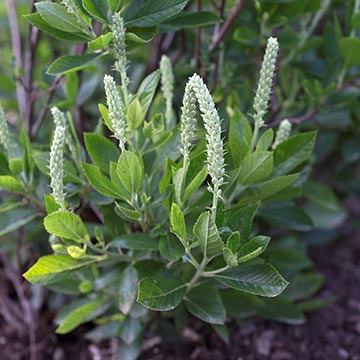Homeowners, businesses, municipalities and others apply more than 15 billion tons of ice melt products to sidewalks, parking lots and driveways each year, according to Purdue University. Although these products make for safe travel on foot or in a vehicle, they are not good for lawns, trees, shrubs or perennials.
How Salt Damages Plants
De-icers used on streets and roadways are about 98 percent sodium chloride, or salt. The spray of slush from passing vehicles poses the greatest threat to the health of lawn or beds adjacent to roadways.
 Boxwood and other plants likely will turn brown if exposed to toxic levels of sodium chloride, a common ingredient in de-icers.
Boxwood and other plants likely will turn brown if exposed to toxic levels of sodium chloride, a common ingredient in de-icers.
© Gail Ruhl/Purdue University Plant Pest Diagnostic Laboratory
Once melted and mixed with water, salt ions separate (sodium and chloride) and replace beneficial nutrients in the soil, making them unavailable to plants and reducing their ability to make chlorophyll. Salt also soaks up water that normally would be available to roots, causing them to dry out. Salty slush sprayed on leaves and twigs causes them to dehydrate and reduces their ability to withstand winter temperatures.
There’s not a lot gardeners can do to protect plants from the splashed slush. A burlap screen or snow fencing placed between the bed or edge of lawn and the road will give some protection.
 White oakleaf hydrangea
White oakleaf hydrangea
Salt Tolerant Plants for Roadside Gardens
The best defense is a great offense. Options may include moving the beds if possible or planting salt-tolerant plants. Some plants to consider: summersweet (Clethra alnifolia), oakleaf hydrangea (H. quercifolia) and mugo pine (Pinus mugo) shrubs and yarrow (Achillea spp.), coral bells (Heuchera spp.) and aster (Symphyotrichum spp.).
 Summersweet
Summersweet
Salt Damage to the Lawn
De-icers containing salts have the potential to damage your lawn if used in large amounts over the winter, especially as snow gets pushed off onto the lawn from the road, driveway or walkways that are cleared.
As the grass greens up later in spring it will be obvious how much, if any, grass has died. In most cases the grass damaged by de-icing salts will recover on its own. Melting snow, and rain in the spring, will often flush the accumulated salts from the soil. The flushing of salts will help the grass recover. Recovery may take 6 or 8 weeks or more as the grass fills in the damaged areas.
If damage is more severe and the lawn has greened-up except for areas near the sidewalks or driveway, you may need to reseed these trouble spots. Where there are several areas of dead grass, combine quality grass seed with GreenView Fairway Formula Seeding Success, a combination product of paper mulch, starter fertilizer and a tackifier used to help grass seed germinate in newly seeded areas. The paper mulch is biodegradable, which means no clean-up once the grass seed germinates.
Use a heavy rake to remove all the dead grass from the damaged areas. Discard the dead grass. Use the rake or a shovel to loosen the top ¼–½ inch of soil to create a good seed bed. Spread the seed and Seeding Success following label directions and water regularly until the new grass has become well-established.
Here's a step-by-step guide to fixing bare spots on the lawn.
Driveways and Sidewalks
The threat of salt toxicity to plants or lawn along sidewalks and driveways comes when treated snow is cleared from the pavement and piled along the edges. It’s also possible that plants along paved areas that have been treated with de-icers could be damaged by the watery solution that seeps into the soil.
For these areas, clear the pavement before applying ice melt products. Many times, clearing sidewalks and driveways of snow reduces or eliminates the need for de-icers. When using a de-icer, use as little as possible. Select a product that is labeled safe for plants (and usually pets). Plant and pet safe products are made of calcium magnesium acetate or calcium chloride.
There also are alternatives, which primarily provide traction, rather than melt ice or snow. These include clean, non-clumping kitty litter, saw dust, coffee grounds or sand. Be careful about tracking these products indoors.
By Jo Ellen Meyers Sharp